Today’s Current Affairs: 6th June 2024 for UPSC IAS exams, State PSC exams, SSC CGL, State SSC, RRB, Railways, Banking Exam & IBPS, etc
Table of Contents
World Environment Day 2024:

World Environment Day is celebrated on 5th June every year to encourage awareness and environmental protection.
- In a remarkable initiative to combat deforestation and restore biodiversity, two environmentalists have spearheaded the creation of India’s first biospheres within tiger reserves.
- The United Nations Assembly established World Environment Day in 1972, which was the first day of the Stockholm Conference on the human environment.
- World Environment Day (WED) is celebrated every year with a specific theme and slogan that focuses on the major environmental issues of that time.
- WED 2024 is hosted by Saudi Arabia.
- India hosted the 45th celebration of World Environment Day in 2018 under the theme ‘Beat Plastic Pollution’.
- WED celebration in 2021 kicked off the UN Decade on Ecosystem Restoration (2021-2030) which is a global mission to revive billions of hectares, from forests to farmlands, from the top of mountains to the depth of the seas.
- The theme for 2024: Land Restoration, Desertification and Drought Resilience
- Year 2024 also marks the 30th anniversary of the UN Convention to Combat Desertification (UNCCD).
Blaze Star : Celestial Event

The upcoming explosion of “Blaze Star” (T Coronae Borealis), a rare celestial event, will be visible to the naked eye for the first time since 1946. This event highlights the dynamic nature of the universe and the complex processes governing stellar evolution.
- Blaze Star is officially known as T Coronae Borealis (T CrB), is a dim star located 3,000 light-years away from our solar system.
- It is found in the constellation Corona Borealis (the “Northern Crown”).
- The Blaze Star is a rare example of a recurrent nova, occurring once in every 80 years.
- Stellar components: The nova involves a binary star system comprising a white dwarf and a red giant.
- The white dwarf draws material from the red giant, leading to periodic explosive increases in brightness.
- The explosion occurs when the red giant’s surface temperature escalates dramatically, causing it to shed material onto the white dwarf, which then ignites a thermonuclear explosion.
- The upcoming stellar explosion is expected to be visible with the naked eye and shine as brightly as Polaris, the North Star, for about a week.
- NASA predicts this event to occur sometime between now and September of 2024.
- Past notable eruptions of T CrB were recorded in the years 1946 and 1866, with earlier documented observations dating back to 1787 and 1217.
- Novae like T CrB occur once every few decades to a century, differing from supernovae in scale, frequency, and consequences.
- Unlike supernovae, novae do not destroy the star system but allow it to reset and repeat the cycle.
Zircon Mineral:

The study of zircon crystals has revealed that Earth had the necessary conditions to support life much earlier than previously thought. It reveals the early interaction of water and land, challenging existing theories of a water-covered Earth.
- Zircon is a mineral belonging to the group of nesosilicates. Its chemical name is zirconium silicate and the chemical formula is ZrSiO4.
- Zircon crystals are notable for their high refractive indices and strong lustre.
- They are naturally occurring in a variety of colours, including clear, green, red, yellow and brown.
- Zircon is used for radiometric dating due to its trace uranium content, allowing precise age determination.
- Its high resistance to weathering makes it valuable for studying sedimentary and metamorphic rock history, providing insights into geological and crustal development over billions of years.
- Zircon grains are important for studying early Earth conditions. They can preserve isotopic signatures that provide insights into the environment and temperatures of ancient Earth.
- Zircon crystals found in the Jack Hills in Western Australia’s Midwest can be up to 4.4 billion years old, providing insight into early Earth.
- The study of oxygen isotopes in zircon crystals reveals the presence of fresh water and dry land on early Earth, challenging existing theories of a water-covered Earth.
None Of The Above(NOTA) Option:

The “None of the Above” (NOTA) option has emerged as the runner-up in Madhya Pradesh’s Indore constituency, securing a record-breaking 2,18,674 votes, the highest-ever tally.
- NOTA (None of the Above) is a voting option on the ballot that allows voters to indicate disapproval of all contesting candidates without choosing any of them.
- NOTA empowers the electors to express their negative opinions and a lack of support for the contenders.
- It gives them the right to reject while maintaining the secrecy of their decision.
- NOTA was used for the first time in the 2013 Assembly elections in five states-Chhattisgarh, Mizoram, Rajasthan, Delhi and Madhya Pradesh-and later in the 2014 General Elections.
- It was introduced into the electoral process following the 2013 Supreme Court directive in the PUCL versus Union of India case.
- The Election Commission clarified that votes cast as NOTA are counted, but are considered ‘invalid votes’.
- Even if NOTA votes get the most number of votes in a constituency, the next candidate with the second-most number of votes is declared the winner.
- Therefore, votes made to NOTA do not change the outcome of an election.
Neo : Novel Protein:

Recent research has discovered a novel protein, referred to as “Neo,” which plays a critical role in bacterial defence mechanisms against viral infections, particularly bacteriophages.
- It was reported by researchers led by Stephen Tang and Samuel Sternberg in a 2023 preprint paper on bioRxiv while working on Klebsiella pneumoniae.
- Bacteria defend themselves from viral infection (against bacteriophages) using diverse immune systems, many of which sense and target foreign nucleic acids. Defense-associated reverse transcriptase (DRT) systems are one of them.
- In the DRT-2 system, the bacteria undergo de novo gene synthesis via rolling-circle reverse transcription (RT) of a non-coding RNA (ncRNA).
- In uninfected bacterial cells, the ncRNA and RT enzyme lead to the synthesis of a repetitive single-stranded cDNA.
- The presence of phage triggers the second-strand cDNA synthesis, leading to the production of long double-stranded DNA.
- This double-strand cDNA generates messenger RNAs that encode a stop codon-less, never-ending open-reading frame (neo) whose translation (neo protein) causes potent growth arrest (cell dormancy) of bacteria. It protects the larger bacterial population from the spread of phage.
Parengyodontium album : Marine Fungus
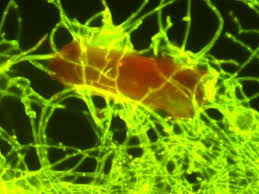
A marine fungus called Parengyodontium album has been discovered to break down plastic polyethene (PE) in the ocean.
- Parengyodontium album is a marine fungus that can break down plastic polyethene (PE), the most common plastic in the ocean.
- It was discovered by Marine microbiologists from the Royal Netherlands Institute for Sea Research (NIOZ).
- In this bioremediation process, the PE-derived carbon is converted into the fungal biomass of album, serving as its energy source.
- Initial photodegradation of PE by UV sunlight is crucial for this process. It makes the fungus useful to degrade the floating oceanic plastic litter.
- Humans produce over 400 billion kilograms of plastic annually, much of which ends up in the ocean.
- Considering fungi as the ‘masters of degradation’ that they utilise a plethora of digestive enzymes for plastic degradation, researchers expect that there could be more plastic-degrading fungi in the deeper parts of the ocean.
World’s Largest Grain Storage Plan:
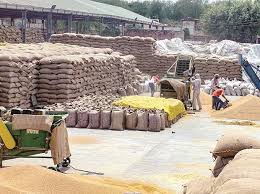
The National Level Coordination Committee (NLCC) for the world’s largest grain storage plan held its first meeting in Delhi.
- The plan aims to transform Primary Agricultural Credit Societies (PACS) into Multi-Service Societies.
- The pilot project, implemented in 11 states, focuses on creating agricultural infrastructure at the PACS level, including warehouses and processing units, through various government schemes.
- The Ministry of Cooperation will implement a pilot project in at least 10 districts to gather regional insights for nationwide implementation.
- An IMC will modify guidelines and implementation methodologies for creating infrastructure at Primary Agricultural Credit Societies (PACS) using available schemes.
- The ministry will implement it through the National Cooperative Development Corporation with support from NABARD, FCI, and others
- The plan aims to address the agricultural storage infrastructure shortage and enable PACS to function as procurement centres, fair price shops, custom hiring centres, and processing units.
- It will reduce food grain wastage, enhance food security, prevent distress sales, reduce transportation costs, and strengthen PACS.
- The National Level Coordination Committee was formed within one week of approval. Implementation guidelines are issued within 15 days of approval.
- Portal for PACS linkage rolled out within 45 days of approval.
- Implementation starts within 45 days of approval.
- FCI is a nodal agency responsible for procurement, storage and movement of food grains, public distribution and maintenance of buffer stocks.
- FCI, set up under the Food Corporation’s Act 1964, works under the Ministry of Consumer Affairs, Food and Public Distribution.
- CWC established under Warehousing Corporations Act, 1962 for warehousing of agricultural produce and other notified commodities
World Summit On The Information Society:

India played a significant role in the ITU’s WSIS+20 Forum High-Level Event and the ‘AI for Good’ Global Summit. During these events, India showcased its leadership in drafting global standards for responsible and trustworthy AI.
- The WSIS+20 Forum commemorates 20 years of progress since the World Summit on the Information Society (WSIS), which occurred in Geneva in 2003 and Tunis in 2005.
- This annual forum, co-organized by ITU, UNESCO, UNDP, and UNCTAD, aims to create a multi-stakeholder platform addressing issues raised by information and communication technologies inclusively at national, regional, and international levels.
- Its goal is to foster a people-centric, inclusive, and development-oriented Information Society, enabling universal access, utilization, and sharing of information.
Preston Curve : Study
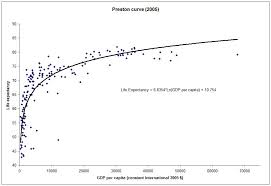
The Preston curve refers to the empirical relationship between life expectancy and per capita income in a country, proposed by American sociologist Samuel H. Preston in 1975.
- The curve shows that people in richer countries generally have longer life spans compared to those in poorer countries, likely due to better access to healthcare, education, nutrition, etc.
- As a poor country’s per capita income rises, its life expectancy increases significantly initially.
- For example, India’s per capita income rose from Rs 9,000 in 1947 to
- Rs 55,000 in 2011, while life expectancy increased from 32 to 66 years.
- However, the positive relationship between per capita income and life expectancy starts to flatten out beyond a certain point, as the human lifespan cannot be increased indefinitely.
- The positive relationship shown by the Preston curve applies can also be applied to other development indicators like infant/maternal mortality, education, healthcare, etc.
Breeding And Nurturing Of Striped Hyenas And Asiatic Wild Dogs : Indira Gandhi Zoological Park
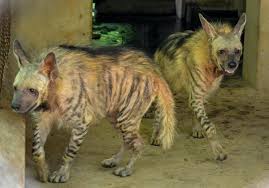
The Indira Gandhi Zoological Park (IGZP) in Visakhapatnam has been at the forefront of wildlife conservation in India, particularly in the successful breeding and nurturing of Striped hyenas and Asiatic wild dogs (Dhole).
- Indira Gandhi Zoological Park (IGZP) is an ex-situ facility established in 1977, located amidst Seethakonda Reserve Forest in the Visakhapatnam district of Andhra Pradesh.
- It is surrounded by Eastern Ghats on three sides and the Bay of Bengal on the fourth side.
- It is a large category zoo recognised by the Central Zoo Authority.
- Due to its close proximity to Kambalakonda Wildlife Sanctuary it is also home to many free-ranging animals and birds.
- IGZP has successfully bred striped hyenas, wild dogs, Indian grey wolves, ring-tailed lemurs, Indian bison, blue and gold macaws, jungle cats, and eclectus parrots.
Dhole (Cuon alpinus):
- It is a wild carnivorous animal and is a member of the family Canidae and the class Mammalia.
- Conservation:
- Wildlife Protection Act, 1972: Schedule II
- International Union for Conservation of Nature’s Red List: Endangered
- The Convention on International Trade in Endangered Species of Wild Fauna and Flora (CITES): Appendix II
- The creation of reserves under Project Tiger provided some protection for dhole populations sympatric with tigers.
Striped Hyenas
- The Striped hyenas (Hyaena hyaena) are one of the three hyena species.
- Other hyena species include Brown hyenas, and Spotted hyenas (the largest).
- They are smaller and less social than the more well-known Spotted hyena.
- Protection Status:
- IUCN Status: Near Threatened
- Wildlife Protection Act, 1972: Schedule I
KASA : South Korea’s Space Agency

South Korea has officially launched its space agency, the Korea AeroSpace Administration (KASA), to lead policy and industrial development in its aerospace sector.
- South Korea has officially launched its space agency, the Korea AeroSpace Administration (KASA), to lead policy and industrial development in its aerospace sector.
- The establishment was made possible after the Country’s national assembly passed a special law in January to unify government organizations in charge of space policy and projects.
- The new agency is based in Sacheon, South Gyeongsang Province, with an annual budget of 758.9 billion won ($556 million).
National Space Agency (KASA)
- The Korea Aerospace Administration (KASA) will lead the country’s “space economy,” with hundreds of businesses and enterprises working to catapult South Korea into the ranks of the world’s top five space powers, Yoon said.
- “KASA will usher in a new space era by cultivating experts while intensively supporting the aerospace industry ecosystem and fostering challenging and innovative R&D,” Yoon said.
- The country’s first lunar lander is planned for 2032.
- South Korea became the seventh country to own an indigenous space launch vehicle and satellite development technology with the launch of the Nuri rocket in May last year that put a commercial grade satellite in orbit.
- The agency is aimed at streamlining policy and development functions shared among different government ministries and will bring under its structure the aerospace research institute that developed the Nuri and its precursor space launch vehicles.
- South Korea plans at least three more space launches by 2027 and has plans to launch military satellites.
Om Birla Becomes First Lok Sabha Speaker In 20 Years To Be Re-elected As MP:

Om Birla, the incumbent Lok Sabha Speaker, has achieved a remarkable feat by winning the Kota parliamentary seat on June 4, 2024. With a resounding margin of 41,139 votes, Birla has become the first presiding officer in 20 years to be re-elected to the Lower House of Parliament.
- The last Lok Sabha Speaker to secure re-election to the Lower House was P.A. Sangma, who served as the presiding officer during the 11th Lok Sabha from 1996 to 1998.
- Sangma, then a member of the Congress party, was re-elected from Tura in Meghalaya in the 1998 Lok Sabha election.
- In 1999, G.M.C. Balayogi from the Telugu Desam Party (TDP) was elected as the Lok Sabha Speaker from Amalapuram in Andhra Pradesh.
- Tragically, Balayogi passed away in a helicopter crash in 2002.
Priyanka Jarkiholi : Lok Sabha 2024 Election

Priyanka Jarkiholi, running for the Congress party, beat Annasaheb Jolle, the sitting MP for the Bharatiya Janata Party (BJP), in the Chikkodi district, which was a big win for her.
- This win is important because the BJP won all but one of the seats in the Mumbai-Karnataka area.
- With her recent election win, Priyanka broke a lot of records.
- She is one of the youngest people to make it into Parliament, at 27 years and one month. She is also the first woman from a tribal background to win a seat in Karnataka’s parliament from an open district.
- This is similar to what Kotturu Hariharappa Ranganath did when he was a Lok Sabha member from Chitradurga from 1984 to 1989.
India’s Third-Largest Export Market In The Fiscal Year 2023–24 : Netherland

The Netherlands became India’s third-largest export market in the fiscal year 2023–24, after the US and the UAE.
- This was the case even though India’s total exports of goods fell by 3%, according to reports from the Commerce Ministry.
- This rise has been emphasized even though trade between the two countries is going down. In 2022–23, it went from $27.58 billion to $27.34 billion, a small drop.
- There has been a lot of growth in India’s exports to the Netherlands.
- The main areas of growth are petroleum products, electrical items, chemicals, and pharmaceuticals. Oil goods were the most important, with $14.29 billion worth of exports in the last fiscal year.
- India’s trade with the Netherlands has been steadily growing, going from $880 million in 2000-01 to $22.36 billion in 2023-24—a 3.5% rise from $21.61 billion in 2022-23.
- In the end, India’s trade balance with the Netherlands grew from $13 billion the previous year to $17.4 billion the last fiscal year.
Wheat Imports : After 6 Years Gap
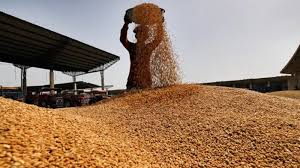
India, the world’s second-largest wheat producer, plans to begin wheat imports after a six-year gap to replenish depleted reserves and control rising prices, driven by three consecutive years of disappointing crops.
- New Delhi is expected to abandon a 40% tax on wheat imports this year paving the way for private traders and flour millers to buy from producers such as top exporter Russia, albeit in modest volumes.
- India’s wheat production has declined in the last 3 years due to unfavourable weather conditions, leading to a sharp drop in wheat output.
- The government estimates this year’s wheat crop to be 6.25% lower than the previous year’s (2023) record production of 112 million metric tons.
- As of April 2024, wheat stocks in government warehouses have dropped to 7.5 million tons, the lowest in 16 years, due to the government selling over 10 million tons from its reserves to control domestic prices.
- The government’s target for wheat procurement in the year 2024 was 30-32 million metric tons, but it has managed to buy only 26.2 million tons so far.
- Domestic wheat prices have stayed above the government’s minimum support price (MSP) of 2,275 rupees per 100 kg and have been on the rise recently.
- So, the government decided to remove the 40% import duty on wheat to allow private traders and flour millers to import wheat, primarily from Russia.
Mission Karmayogi:
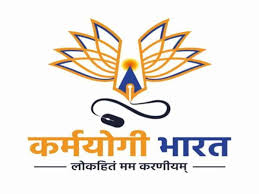
Indian Institute of Public Administration assessed the impact of mission karmayogi by seeking inputs on recently trained staff from their supervisors and reported increased proficiency in data analytics and e-governance tools
- Improved governance and efficient and competent civil services are required for achieving India’s ambitions.
- Mission Karmayogi, also known as the National Programme for Civil Services Capacity Building (NPCSCB), is an ambitious program launched by the Government of India.
- The mission was launched by the Union Cabinet on 2nd September 2020.
- It aims to transform the government’s human resource management, making the bureaucracy more efficient, effective, and accountable.
- The goal is to develop the skills and competencies of civil servants to deliver better results for citizens.
- The mission intends to lay down the foundations for the Indian civil servants’ capacity building and aims to enhance governance.
- Mission Karmayogi include Shift from rule to role-based training and capacity building: Capacity building of government officials under Mission Karmayogi focuses on enhancing the attitudes, skills, and knowledge of these individuals through role-based training.
- Moving to a competency-driven approach for capacity development: A competency-driven capacity building approach focuses on developing competencies critical for public officials to effectively undertake their various roles.
- Democratising and enabling continuous, lifelong learning opportunities: Mission Karmayogi aims to make available to all government officials, across hierarchies and geographies, the opportunity to continuously build and strengthen the competencies required for their roles.
- The NPSCSB aims to embark on a learning transformation program that will address the capacity building issues of the Civil Services through a comprehensive online platform – iGOT Karmayogi.
- iGOT Karmayogi aims to provideonline, face-to-face and blended learning and manage lifelong learning records of the officials.
PraVaHa Software:

SRO’s Vikram Sarabhai Space Centre (VSSC) develops PraVaHa (Parallel RANS Solver for Aerospace Vehicle Aero-thermo-dynamic Analysis), a Computational Fluid Dynamics (CFD) software for aerodynamic design and analysis of aerospace vehicles.
- PraVaHa simulates external and internal flows on launch vehicles, winged, and non-winged re-entry vehicles, aiding in the evaluation of aerodynamic and aerothermal loads during launch and re-entry.
- It is extensively used in the Gaganyaan program for analyzing human-rated launch vehicles and is designed to utilize CPU and GPU architectures for efficient simulation.




